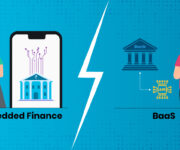Every company at some point needs integrated financial services as a part of its service offering. Integrated financial services is an umbrella term that comprises different aspects related to finance such as payments, insurance, investments etc. This need was widely recognised as ‘Embedded Finance’.
With the widespread adoption of digital technology by consumers across industries, businesses have realised that they cannot turn their backs on a digitised way to continue their businesses.
To fulfil this requirement, companies had to create a separate fintech department. However, this came with its own set of problems: significant expenditure and a lot of time. This prompted the introduction of embedded finance, which enabled native fintech experiences for every business possible and took the world of fintech by storm.
In simpler words, embedded finance is a seamless integration of financial services into a traditionally non-financial service. A simple example would be making cashless payments while ordering food from a food delivery mobile app.
Embedded finance has given businesses opportunities to scale their operations along with helping to monetise their customer base. Notably, embedded finance is expected to turn into a $7 trillion market by 2030, given its massive demand across banks, fintech and other non-financial brands!
Embedded Finance – Innovation That Took the World of Fintech by Storm
Embedded finance has found the following use cases, highlighting the fact that we are currently surrounded by embedded finance in most aspects of life.
Embedded Payments:
When it comes to making payments, we have reached a new level of high, all thanks to fintech companies. The most obvious use case of embedded payments is probably Uber or Starbucks, which allow payment for the products and services through their mobile apps. These apps are integrated with an embedded payment program which consumers can use and make payments by simply tapping a few buttons.
Also, the demand for embedded payments is being felt at the product level across all small businesses in a strategic way. This involves not only handling payments but also equipping the merchants with the required tools to make analytical decisions.
Such value-added services will enable merchants to enjoy a better software experience, retain customers and keep the product prices in check.
Embedded Investments:
Investing in the stock markets has mostly remained a grey area for non-specialists. However, this seems to be changing with the adoption of embedded investments by investment firms. For example, brokerage firms have pioneered embedded investing as a part of their service offering, enabling an average investor to invest seamlessly.
By leveraging technology, these firms have built APIs to reflect all of their services such as opening an account, trading, portfolio management, etc.
Embedded Credit:
Earlier, if a customer required a loan for any purchase, they had to typically visit a bank. With the help of embedded credit, it is possible to apply for and acquire loans right at the point of purchase without even leaving the platform.
For instance, a customer purchasing a mobile phone from Amazon can opt for EMI payments instead of a lump sum amount right at the checkout page.
Finezza’s Loan Origination Software assists lenders with features such as automatic KYC document extraction, easy API integration, loan eligibility estimator, customer servicing, etc. thus enabling them to integrate embedded credit and facilitate a smooth lending experience.
Embedded Insurance:
One of the best use cases of embedded insurance is when a customer purchasing a car is instantly texted the insurance offerings by the car dealer. Tesla is one such company that offers auto insurance when making an online purchase through their website or even in-person buys at their physical showrooms.
With the help of transactional APIs and technologies, it is possible to integrate insurance solutions and help customers avail the same without interacting with an insurance provider separately.
Benefits of Embedded Finance to Banks/NBFCs:
There are multiple use-cases of embedded finance, and here is why it has taken the fintech world by storm:
More Customers:
Embedded finance gives financial institutions access to a large pool of borrowers. As a result, they are in a position to leverage such huge numbers and expand their customer base. For example, Amazon’s massive network of small businesses can automatically become the potential customers for partnering banks/NBFCs.
More Profits:
A good loan origination and management system help financial institutions to concentrate lending efforts in a streamlined manner, which results in increased margins and lower costs for end customers.
More Business:
Since the financial institutions have access to a large pool of customers, they can offer products tailored to individual customers’ needs and drive repeat transactions. This leads to more business and an increased bottom line.
Improved Customer Experience:
Embedded finance helps increase customer satisfaction by giving them better options. Financial institutions can cater to them more meaningfully by providing access to the embedded banking system. This improves customer experience overall and adds an extra hat in the feather for banks/NBFCs.
How Can Loan Management Softwares Help?
Loan management systems help financial institutions automate their loan lifecycle completely. Here are some features with which a loan management software can prove to be of great help:
Loan Origination:
The process of loan origination involves a borrower applying for a loan and a lender processing the loan. A lending CRM will ease out the whole loan origination process by checking an individual’s credit history to evaluate risks. It helps analyse the application and even suggest what type of loan best suits the client.
Loan Servicing:
Once the loan is originated, the next step involves the management of the loan. Since every loan is different from the other concerning interest rates, tenure and other such requirements, it makes sense to deploy a loan management solution. It helps keep track of all the payments, calculate interests and fees as well as collect funds.
Finezza’s loan management system assists banks, NBFCs and other financial institutions with 360-degree customer profile assessment, credit assessment tools, provides loan analytics and reports, superior threat detection and much more.
The pandemic has made a strong case for the use of embedded finance in all aspects of our life, which will continue to grow further as it opens up new and innovative opportunities for fintech.




Leave a Reply